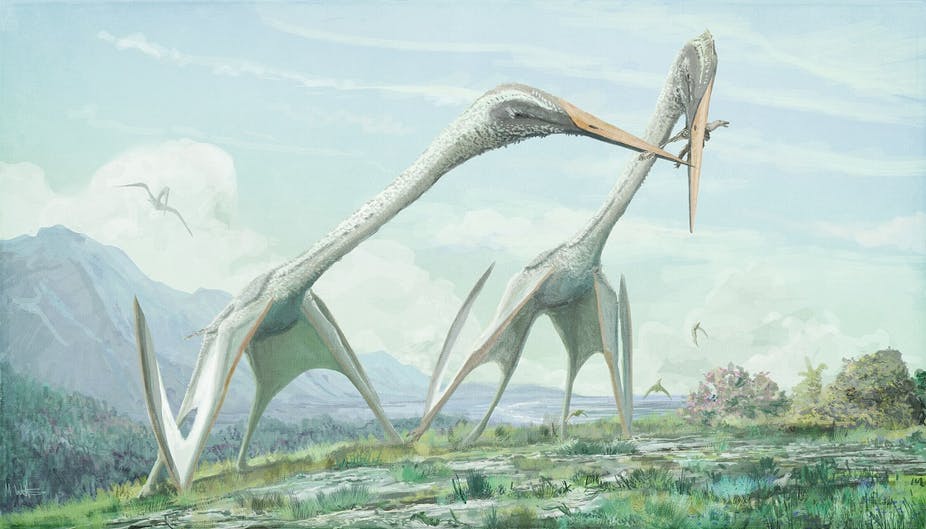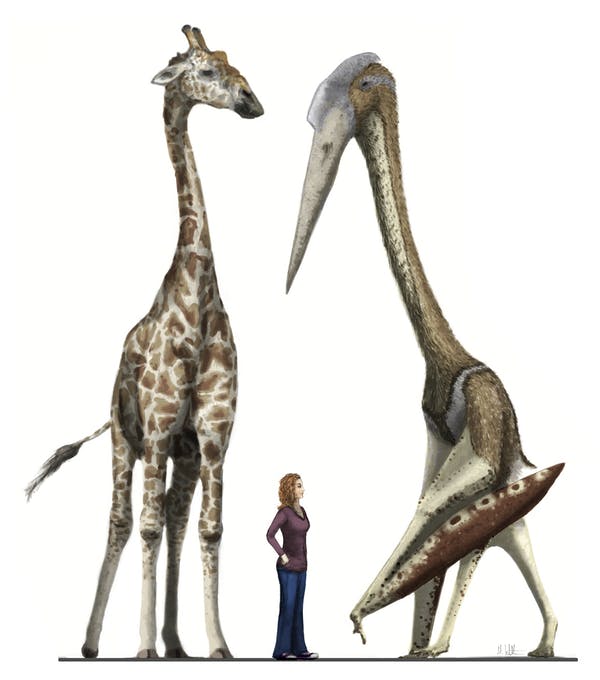
Pterosaurs were the very first vertebrates to evolve powered flight nearly 230 million years ago. Previously, only insects were capable of flying. But these first fliers were a bit clumsy, and it took a while before pterosaurs could reach their full potential. According to a new study published today in the journal Nature Communications, the ancient flying reptiles became better fliers at a constant rate until they went extinct 65 million years ago.
“Meaning that on average for 150 million years descendants were better flyers than their ancestors. This is a quite striking and unique demonstration of Darwin’s idea of descent with modification as species get better in their environment. I was certainly surprised to see such a clear demonstration of that!” Chris Venditti, Lecturer in Evolutionary Biology at the University of Reading in the UK and lead author of the new study, told ZME Science.
Bigger, better fliers
Pterosaurs were airborne animals that were closely related to dinosaurs. Like other flying animals, these reptiles generated lift with their wings, performing the same kinds of motions as birds and bats. They became quite good at it, traveling over long distances where they occupied new habitats across the world. Eventually, they branched out into an enormous array of species, including the largest winged-animals ever.
But this journey wasn’t straightforward. By studying the fossil records by employing new statistical methods, Venditti and colleagues reconstructed the evolution of the pterosaur flight dynamics across millions of years. Their findings suggest that natural selection acted to increase flight efficiency in these animals constantly since the time they first appeared in the fossil record until their premature extinction when an asteroid impact wiped them out, along with all non-avian dinosaurs.
There was only one exception to this pattern.
“A group of pterosaurs called azhdarchoids buck this trend. There are many hints in the scientific literature that suggests that this group had more terrestrial affinities than other pterosaurs. Some had inflexible necks which are not ideal for efficient flying, others left fossil tracks indicating terrestrial proficiency, and yet others had adaptations associated with ground-dwelling generalist foraging or wading foragers that fed on hard-shelled organisms at water margins. So, it seemed that these azhdarchoid pterosaurs did not rely on flight so much and our results support that – whilst they could fly, they might have only done so when they needed to. Some of these groups of pterosaurs were enormous (as tall as a giraffe),” Vendetti said.

Besides increasingly better flight performance, the researchers also showed that pterosaurs grew in size over time but only after birds first appeared. According to Vendetti, this was expected given Cope’s Rule — the tendency for organisms in evolving lineages to increase in size over time — and the interactions between the two groups of flying animals suggest that birds outcompeted pterosaurs at the small size range.
Interestingly, pterosaurs not only got bigger, their wings grew even larger.
“Through time pterosaurs got bigger wings than we would expect for their size – their relative wing size increased through time. So, they got bigger, but the wings got even bigger! All other things equal then, in turn, this leads to increased flight performance. In Azhdarchoids that buck the trend, even though they were some of the largest pterosaurs, relatively speaking they had small wings (for their size),” Vendetti said.
From beetles to fish: how pterosaur diet evolved
Another article published today in the same edition of Nature Communications also investigated pterosaur evolution, this time from a dietary perspective.
By studying the wear and tear of fossilized teeth from numerous pterosaur species, researchers at the University of Birmingham in the UK, led by Jordan Bestwick, could reconstruct what 17 different species of pterosaurs ate.
Dimorphodon, for example, ate a mix of vertebrates, Rhamphorhynchus ate fish, and Austriadactylus ate ‘hard’ invertebrates such as beetles and crustaceans, the authors concluded.
“I found large dietary diversity between pterosaurs as a group, ranging from carnivores, piscivores (fish eaters) to consumers of crunchy invertebrates and even generalists. In some instances this reaffirmed our current understanding of the diets of some species, whereas in others they provided completely new insights into diet,” Bestwick told ZME Science.
The researchers were able to infer what pterosaurs ate millions of years ago by studying the marks left on their teeth. Different kinds of foods leave different impressions, which reflect a creature’s diet.
Bestwick and colleagues used a technique called microwear texture analysis, which they previously employed on modern reptiles such as crocodiles and monitor lizards. Since the technique was able to determine foods found in known modern reptile diets, the researchers were confident to try it out on extinct reptiles such as pterosaurs.
“We found that the earliest pterosaurs consumed mostly invertebrates and that the later species were the more obligate carnivores and piscivores. What was really interesting is that this dietary shift sped up around the 150 million year mark which is around the same time that birds were evolving. Further study is needed to know whether our finding is just a coincidence or actually represents a trend where the evolution of birds changed the trajectory of pterosaur evolution, but does provide a new voice into the fiercely debated topic on pterosaur and bird competition,” Bestwick said.
“We also found evidence of one pterosaur shifting its diet as it grew up. Rhamphorhynchus lived in Germany around 150 million years ago and its complete life-history is preserved in the fossil record, from hatchlings no bigger than a sparrow, to adults about the size of a gannet. As Rhamphorhynchus grew up it shifted its diet from invertebrates to fish. This dietary shift is observed in many crocodilians and gives a clue into how pterosaurs looked after their young. Most reptiles do not feed their young and so young individuals eat different foods to the adults. Birds, on the other hand, feed their helpless young and so the young are consuming the same foods as the adults. That Rhamphorhynchus changed its diet provides a clue that maybe pterosaurs grew up like reptiles, despite flying like birds,” he added.
The two studies completement each other nicely, enriching our understanding of nature’s pioneering fliers.
“I think our study is a striking demonstration of how natural selection sculpts biological organisms through time by natural selection to be better in their environment. It also provides a blueprint to objectively study evolution through millions of years,” Venditti said.
“Pterosaurs are one of the most famous groups of prehistoric animals in the public eye (although they are colloquially referred to as ‘pterodactyls’) and are like nothing that is alive today. Microwear analysis is truly a window into the past that enhances and even changes our understanding of how these animals lived, grew up and evolved, makes them more like real animals, rather than as monsters you see in films,” Bestwick added.


